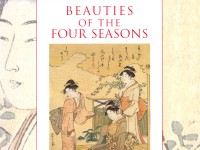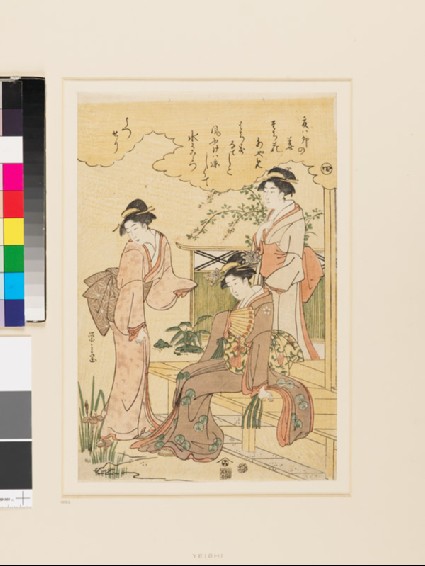Beauties of the Four Seasons
A full catalogue of the Ashmolean’s collection of Japanese bijinga (beautiful women) prints by Mitsuko Watanabe (published Oxford, 2005).

Publications online: 54 objects
Three women watching purple irises, with text from The Tale of Genji
-
Literature notes
Three ladies are looking at some purple iris growing in water. One lady is sitting and holding a fan and another, on the right, is putting her hand to her collar suggesting slightly hot weather with a sense of summer but it is still sometime chilly as the part of the inscription on the top reads kaze fukeba suzushikute (cooler with wind). The beautifully opened Iris probably refers to the season of the Ayame no settku (Iris Festival or tango no settku) in summer but the hagi (bush clover, one of seven grass of autumn) implies the coming of autumn. -
Details
- Series
- The Tale of Genji
- Associated place
- Date
- late 18th century - early 19th century
- Artist/maker
-
Hosoda Eishi (1756 - 1829) (designer)Shikibu Murasaki (c. 973 – 1025) (author)
- Associated people
-
Nishimuraya Yohachi (c. 1751 - c. 1870) (publisher)
- Material and technique
- nishiki-e (multi-block) woodblock print, printed with water-based vegetable pigments
- Dimensions
-
mount 55.5 x 40.5 cm (height x width)
print 32.4 x 21.5 cm (height x width)
- Material index
- Technique index
- Object type index
- No. of items
- 1
- Credit line
- Presented by Mrs Allan and Mr and Mrs H. N. Spalding, 1952.
- Accession no.
- EAX.4101
-
Further reading
Oxford: Ashmolean Museum, 24 August-30 November 2005, Beauties of the Four Seasons, Mitsuko Watanabe, ed. (Oxford: Ashmolean Museum, 2005), no. 21 on p. 42, illus. p. 43
Glossary (2)
nishiki-e, vegetable pigments
-
nishiki-e
Nishiki-e literally means 'brocade pictures' and refers to multi-coloured woodblock prints.
-
vegetable pigments
Vegetable pigments were used to create coloured dyes for Japanese prints, paintings, and textiles. These pigments often faded over time due to the chemical reactions they underwent.
Location
-
- currently in research collection
Objects are sometimes moved to a different location. Our object location data is usually updated on a monthly basis. Contact the Jameel Study Centre if you are planning to visit the museum to see a particular object on display, or would like to arrange an appointment to see an object in our reserve collections.
Publications online
-

Beauties of the Four Seasons
Three ladies are looking at some purple iris growing in water. One lady is sitting and holding a fan and another, on the right, is putting her hand to her collar suggesting slightly hot weather with a sense of summer but it is still sometime chilly as the part of the inscription on the top reads kaze fukeba suzushikute (cooler with wind). The beautifully opened Iris probably refers to the season of the Ayame no settku (Iris Festival or tango no settku) in summer but the hagi (bush clover, one of seven grass of autumn) implies the coming of autumn.
Notice
Object information may not accurately reflect the actual contents of the original publication, since our online objects contain current information held in our collections database. Click on 'buy this publication' to purchase printed versions of our online publications, where available, or contact the Jameel Study Centre to arrange access to books on our collections that are now out of print.
© 2013 University of Oxford - Ashmolean Museum

